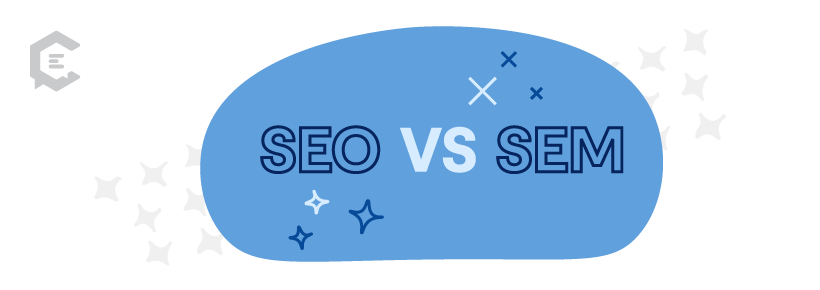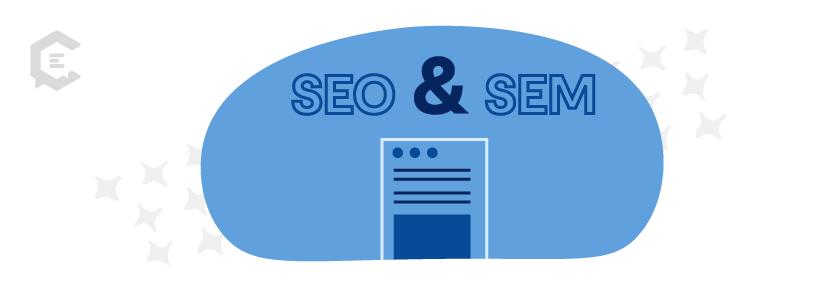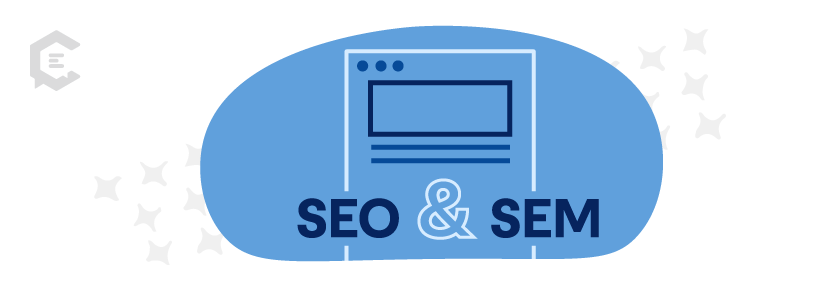SEO vs. SEM vs. content marketing — how do they differ, and how do they work together for maximum results?
Being visible on the internet is all about getting your business in front of the right people at the right time. This is why strategies like search engine optimization (SEO) and search engine marketing (SEM) play such an important role in digital marketing. Moreover, both strategies rely heavily on good content, which is why the three should work seamlessly together to create a bigger impact.
To figure out how to make SEO, SEM, and content marketing work together, you must first understand how each one works. Let’s take a closer look at the different functions and purposes of SEO vs. SEM and the role content marketing plays in both.
SEO vs. SEM — what’s the difference?
Search engine optimization or SEO is the practice of optimizing a site to improve its ranking in organic search engine results pages (SERPs). It involves a variety of non-paid methods to rank in search and may take several months for the results to show.
On the other hand, search engine marketing or SEM is the use of paid methods to gain visibility in relevant search results. It involves using pay-per-click (PPC) advertising that shows up prominently in SERPs, which could deliver instant results.
Here’s a quick overview of the similarities and differences between SEO vs. SEM:
- SEO is organic, whereas SEM is paid.
- SEO results take months to show up, whereas SEM results are almost instant.
- Both SEO and SEM improve visibility in relevant search results and drive traffic.
- Both SEO and SEM rely heavily on good content and keyword targeting to succeed.
How search engine optimization (SEO) works
SEO works by optimizing a site’s ranking signals so that search engines can crawl it effectively and rank it in relevant search results. It requires having high-quality keyword-optimized content, a user-friendly site architecture, and a strong backlink profile. The process typically focuses on the following four SEO components:
- On-page SEO – using relevant keywords to optimize the on-page elements of your website, such as the content, title tag, meta description, and URL.
- Off-page SEO – improving the off-page signals coming from other websites so that search engines can understand the relevance and credibility of your site. It involves getting backlinks from reputable sites with high domain authority (DA) to boost trust and authority signals. Search engines also sometimes look at social media signals to rank your page.
- Technical SEO – making sure that all of your web pages are working optimally so that search engines can crawl and index them. Proper site architecture and fast load speed are some factors that affect this.
- User behavior – such as click-through rate, bounce rate, and time on site. This allows search engines to determine the relevance of your page for a particular search. If people are bouncing soon after they land on your page, search engines might determine that it’s not a good fit for that particular search query.
How search engine marketing (SEM) works
SEM works by running PPC campaigns where you pay a pre-determined fee every time someone clicks on your ad. It requires bidding on a keyword so that your ad will show up to people who search for that keyword. Once someone clicks on the ad, you pay your bid amount to the search engine.
With thousands of advertisers targeting the same keyword, the bid amount plays an important role in determining whose ad shows up in the search. The higher you bid, the more prominently your ad will show up in relevant search results.
Your ad’s Quality Score is another factor that Google considers when deciding your ad position. Google will look at the quality of your ad copy, landing pages, and keywords to determine an appropriate quality score. Not only does a high Quality Score improve your click-through rate (CTR), but it also helps you get a discount on your cost-per-click (CPC).
SEO vs. SEM pros and cons
To gain an even better understanding of the differences between SEO vs. SEM, let’s weigh the pros and cons of each approach. This will help you assess when it’s the best time to focus on SEO or SEM, or both.
SEO Pros
- More budget-friendly than SEM.
- Delivers reliable, long-term results.
- Ideal for informational keywords.
SEO Cons
- Takes time to show results.
- Requires a combination of multiple approaches.
SEM Pros
- Delivers almost instant results
- Enhanced visibility in SERPs
- Ideal for hard-to-rank-for keywords
SEM Cons
- Costs could add up.
- Results are short-term.
Considering the above, it’s best to focus on SEO when you’re on a limited budget, but you don’t mind waiting a few months for the results to show. Alternatively, SEM might be a better option if you want to see instant results and you have a decent ad budget to work with. Many businesses also choose to use a combination of the two to launch a powerful digital marketing/content marketing campaign.
The role of content in SEO and SEM
The success of both SEO and SEM relies heavily on good content. Whether it’s a good blog post, a compelling landing page, or an enticing ad copy. As such, you can tie the two together seamlessly with your content marketing strategy to generate a bigger impact.
Importance of content in SEO
SEO requires a combination of different types of content marketing to deliver results. For starters, you use keywords to develop high-quality content that provides your target audience with the answer they need. This may be an SEO-friendly article to inform readers about an interesting and relevant topic. It may also be a persuasive website copy explaining your service or product to your visitors.
Additionally, you could also submit informative and well-written guest posts on relevant publications to gain quality backlinks and improve your off-page ranking signals. This is why the best content marketing strategies often include a solid guest posting strategy.
You could even extend your efforts to other marketing channels such as social media. Since Google also considers off-page signals like social shares, it’s important that you post interesting and engaging content that gets a ton of shares. All of these combined create an SEO-focused content marketing plan.
Importance of content in SEM
In SEM, there are two areas in which content plays a critical role; your ad copy and your landing page content. Since these are two factors that Google considers when determining your ad Quality Score, you need to focus on optimizing them to bring up your score. This involves writing high-quality copy optimized with relevant keywords.
Plus, your ad copy should be enticing enough to get people to click on the ad, thus improving your click-through rate. Meanwhile, your landing page copy should be compelling enough to drive conversions. This will help you get a high Quality Score and even lower your cost-per-click, ultimately boosting your return on investment (ROI).
Steps to make SEM and SEO work together
With SEO and SEM each having unique benefits and disadvantages, using a strategic combination of the two is the best way to generate higher returns. The following steps will help you get started.
Start with strategic content marketing
Effective content marketing management goes hand in hand with the success of your SEM and SEO efforts. So, an effective way to combine SEM and SEO is by developing a strategic content marketing plan keeping both marketing approaches in mind.
Start by figuring out the different types of content marketing that you’ll need for SEO and SEM. Here are a few ideas to inspire you:
- Develop keyword-optimized website copy for all your service or product pages. This improves your chances of ranking in organic search results. Plus, the high-quality copy will improve your ad Quality Score if you use them for your PPC ads.
- Produce informative blog posts regularly. The blog post topics can focus on specific keywords that are relevant to your business to improve your search visibility. In fact, blogging has resulted in up to a 372% increase in organic traffic for some businesses. You can further amplify the visibility of your blog posts by pushing them in relevant search ads.
- Create lead magnets such as whitepapers, ebooks, templates, training videos, webinars, case studies, and studies. Offering the right lead magnet is an effective content marketing strategy to generate high-quality leads from your SEO and SEM efforts.
Once you have this plan outlined, the next step is to start developing the content. Consistency and quality are key here, so don’t hesitate to get help if you have too much on your plate. Consider working with experts who offer content writing services to help you develop the kind of high-quality content you need.
Leverage SEM data insights for SEO
SEM campaigns generate tons of valuable data about how certain keywords are performing or how people are responding to your ads and landing pages. This type of data can help you fine-tune your SEO strategy for a bigger impact.
The CTR on your ads, for example, can tell you what headlines and descriptions resonate with your audience. You can then use this messaging to optimize your website content for SEO. Additionally, if certain keywords are gaining lots of impressions, there’s potential to attract significant traffic from those keywords. You could consider developing informational content targeting those keywords to attract organic traffic.
Launch search retargeting campaigns
Search retargeting is an SEM strategy that can maximize the impact of your SEO efforts. It involves serving display ads to people based on the keywords they’ve searched for. For example, a sporting goods store may serve ads to people who’ve recently searched for “cycling shoes” or “hockey stick.”
This helps to get your brand in front of people who may not know about you yet but are showing an interest in the types of products you sell. It’s an effective way to lower the cost of your overall search marketing efforts since you don’t have to bid for highly competitive and costly keywords unlike with PPC.
Putting content at the center of SEO and SEM
The right content marketing plan can make a huge difference in both your SEO and SEM efforts. In fact, it could even help tie the two together to make them work seamlessly. This, in turn, will generate exponential returns for your business.
With good content being instrumental for this, make sure you’re consistently producing high-quality content. Whether it’s blog posts, website copy, landing page copy, ad copy, or even lead magnet content. Consider working with a freelance content marketing writer for flawless execution.









